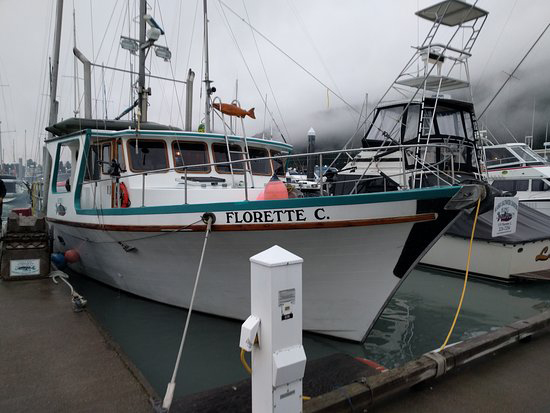The last angler on board the Florette C arrived at precisely the designated departure time. Even before introductions could be extended, Captain Dianne Dubuk was detailing the features of her boat, Coast Guard safety requirements, the location of snacks, and the lunch menu. It was a beautiful, early March morning. Winds were calm; the sun’s first rays were creeping over glacier-dotted hills to the east of Homer’s small boat harbor on the spit. Although El Nino influenced, the warmer-than-usual morning’s slight breeze still had a bite, and the cabin’s warmth felt good as Dianne motored her craft into the open sea.
The latecomer approached the helm observing a bank of the latest fishing and electronic safety gear. Near the console’s center was a small, famed photograph of a lovely lady. Captain Dubuk noticed the latecomer’s question before it was asked.
“That’s my mother. She goes with me on every trip. I talked to her on the telephone last night. Told her you placed an order for clear skies, flat water, and fish. I’ve known for years she has a direct connection with the man upstairs, and I asked her to pray so we could fill your order.” Dianne was laughing when she talked about her mother, but the latecomer could tell she had a sense of believing her own story.
Just down the bay from Seldovia, Dianne slowed the boat and announced, “Get ready to fish.” Those on the charter who were regulars knew Dianne meant draw cards to see who fishes first. A 2-foot wide fishing compartment ran along the entire back of the Florette C. The all-wood boat had spent most of its life as a salmon troller in Southeast Alaska but was now retired to sport fishing. Long poles extended 20 feet on either side. Two downriggers wearing 30-pound cannon balls were attached to a pulley system via a steel cable to the poles. A simple hydraulic system controlled the cannon balls’ depth. As the cannonball sank, deeper marks appeared along the cable, notifying the operator of the depth. At predetermined marks, fishing line was attached to the cable by a clothespin-like device. The terminal end was a foot-long flasher followed by a small hook encased in a 3-inch herring attached commercial-troller-like, not like a conventional sportfishing charter would fix its bait.
The latecomer drew an ace, and one of the regulars a jack, winning them the first chance to fish. Dianne’s deckhand handled baiting and rigging the lines as Dianne maneuvered her boat near the rock face where she intended to troll. As the first line reached the sought-for depth, a telltale jerk developed at the rod’s end. The latecomer set the hook, and the deckhand knowingly announced, “small halibut.”
The latecomer cranked his catch aboard as the deckhand rigged and positioned the other three rods. The first team fished their allotted time and continued to boat or release a string of halibut catches, but no kings, the real target for the day. And so went the second and third shifts. No kings, just small halibut.
When the latecomer and his partner’s time came for their second try, they joked, “Let’s get off this halibut kick.” And they did. One after another, tom cod came aboard, were cursed, and quickly released. But no kings. The other teams experienced a similar catching and releasing.
As the latecomer and his teammate started the third shift, Dianne came to the boat’s back and wished them luck. In passing, the latecomer quipped to Dianne, “Next time, ask your mother to be species-specific. We’re catching fish, but next time ask her to order kings.”
“Okay, that’s the problem?” asked Dianne. “Well, catch a king.”
“Fish on! “shouted the latecomer’s teammate.
“King on,” said Dianne, knowing and reading the wiggle on the rod tip.
The king was boated, then another, and the ice was broken even for the other teams. The fishing day was a success and topped off with a bonus when Florette C stopped and pulled crab pots laid out earlier.
The next time Captain Dianne Dubuk asks her mother to talk to the man upstairs, she’ll undoubtedly be species-specific.



